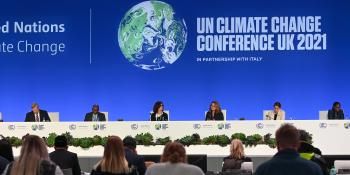Rolling up our sleeves: agriculture, landscapes and greenhouse gas emissions

The world’s population is growing fast, heading towards 9 or 10 billion by 2050. This calls for a huge increase in food production of the order of 70%. But the UN Food and Agriculture Organization (FAO) estimates that only 9% of this increased production can come from bringing more land into production.
Water resources are also already stretched; agriculture already accounts for some 70% of the world’s freshwater use, and alone it will exceed the accessible, sustainable water supply by 2030 (McKinsey, 2009). And on top of all that, agriculture, like all other human activities, is being called on to do its share of curbing greenhouse gas (GHG) emissions, all while minimizing its impact on the ecosystem services that deliver vital goods and services and support human health and well-being.
How can we achieve this? And is it even possible?
These are two of the key questions that will be addressed at a discussion forum on Rolling up our sleeves on agricultural mitigation for landscape benefits at the Global Landscapes Forum on 17 November 2013, 15:00-17:30.
Organized by Farming First, the CGIAR Research Program on Climate Change, Agriculture and Food Security (CCAFS), Climate and Land Use Alliance (CLUA), the Wold Farmers’ Organization (WFO), the United States Department of Agriculture (USDA), Agriculture and Agri-food Canada (AAFC) and the Climate and Clean Air Coalition (CCAC), the forum will identify the main focus areas for mitigation action and some of the knowledge gaps that are constraining action. It will then look at how adopting a landscape approach can help in achieving mitigation targets, and the roles that policy development, capacity building and knowledge transfer can play.
What do we mean by a “landscape approach”? The World Bank puts it clearly and succinctly:
“A ‘landscape approach’ means taking both a geographical and socio-economic approach to managing the land, water and forest resources that form the foundation – the natural capital – for meeting our goals of food security and inclusive green growth. ... The bottom line is that we can’t achieve global food security without preserving the ecosystem services that forests provide, and we can’t sustain forests without thinking of how we will feed a growing population. We can’t grow food without enough water. A landscape approach has the potential to address the full range of critical functions for both provision (of food, fiber, energy and so on) and healthy ecosystems.”
Theun Vellinga from Wageningen University and Research Centre will present a case study that looks at how the livestock sector can reduce its contribution to GHG emissions. Livestock agriculture accounts for about 15% of anthropogenic GHG emissions, both directly, in the form of methane from ruminants and from manure and in the form of nitrous oxide from manure and fertilizers, and indirectly, through clearance of forest to provide pasture for cattle and other feed for livestock in general.

Livestock agriculture accounts for about 15% of GHG emissions. A case study on how to reduce these emissions will be presented on 17 November. Photo: C. Schubert (CCAFS)
There are many ways in which these emissions can be reduced, including changes in feeding regimes (higher energy density diets, for example, can reduce methane emissions from ruminants, and better pasture management can reduce the need to expand the area used for grazing and increase the amount of carbon sequestered) and improved manure management. Faced with a likely 70% increase in demand for livestock products by 2070, we are going to have to exploit all of these means, and more, if the livestock sector is to contribute to mitigating climate change.
Some studies (for example, Smith et al. 2013) show that demand-side mitigation measures, such as reducing demand for livestock products – thus freeing up land for producing food that can be directly consumed by humans – are more likely to benefit food security than are supply-side mitigation measures, such as changes in land management. But both are going to be needed: demand-side measures can be difficult to implement and take a long time to pay off, whereas changes that allow us to produce more food per unit land area can be brought on stream more quickly.
Agriculture is responsible for about a quarter of human-induced emissions of greenhouse gases worldwide. Rice paddies and livestock are major sources of methane, while excessive use of nitrogen fertilizers not only pollutes rivers and lakes but also results in release of nitrous oxide, another potent greenhouse gas. Agriculture produces nearly half of all methane generated by human activity, and nearly 60% of nitrous oxide emissions. Clearing forests to open up new land for agriculture releases enormous amounts of carbon dioxide.

Agriculture is responsible for about a quarter of human-induced emissions of greenhouse gases worldwide, Stemming from for instance
deforestation. Photo: N. Palmer (CIAT)
But agriculture and forests also offer major opportunities to mitigate climate change. There are many proven practical techniques, such as mulching, intercropping, conservation agriculture, crop rotation, integrated crop-livestock management, agro-forestry, improved grazing and improved water management that will help boost the both the productivity and resilience of farming systems.
View a toolkit for how to communicate about agriculture and climate change within the UNFCCC negotiations here.
Integrating these at a landscape level will be a considerable challenge, but the rewards of success will be equally considerable.
Watch the Farming First video: “Story of Agriculture and the Green Economy”.
Paul Neate is a freelance science writer and Michael Hoevel works for Farming First.
The CCAFS team is reporting live from the UNFCCC climate talks in Warsaw, 11-22 November 2013. Click to read all of our coverage. For live updates from the Climate talks in Warsaw, follow us on twitter @cgiarclimate and @bcampbell_CGIAR. Join the conversation using #GLFCOP19.



